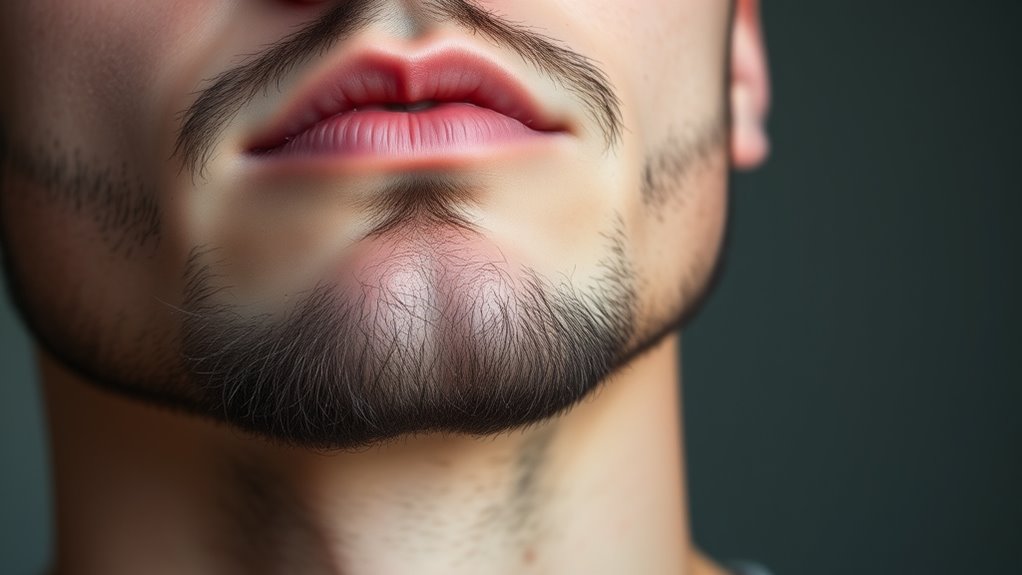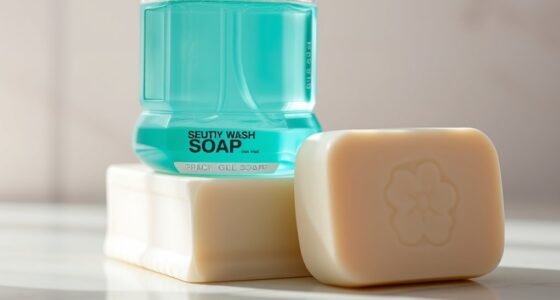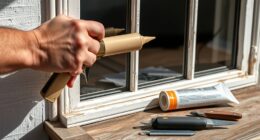To prevent ingrown hairs on your beard and neck, start by softening your skin with warm water or a damp towel before shaving. Use a sharp razor and shave in the direction of hair growth, avoiding multiple passes. Afterward, rinse with cool water and apply a gentle, alcohol-free moisturizer. Regular exfoliation helps clear dead skin, reducing the chance of hairs curling back. Keep these tips in mind—there’s more to explore for smoother skin.
Key Takeaways
- Prepare skin with warm water and gentle exfoliation before shaving to soften hair and remove dead skin.
- Shave in the direction of hair growth using sharp, clean razors to minimize hair breakage and irritation.
- Avoid multiple passes over the same area and refrain from squeezing bumps to reduce inflammation.
- Apply cool water and soothing moisturizer after shaving to close pores and calm the skin.
- Regular exfoliation and using skincare ingredients like salicylic or glycolic acid help prevent follicle clogging and ingrown hairs.

Have you ever noticed a small bump or redness after shaving or waxing? That’s often a sign of an ingrown hair, a common skin irritation that occurs when hair grows back into the skin instead of out of the follicle. It’s especially prevalent on your beard and neck because these areas are frequently shaved or waxed, causing hair to become trapped beneath the surface. While ingrown hairs can be uncomfortable and sometimes lead to infection, there are simple ways to prevent them and keep your skin smooth and healthy.
First, preparation is key. Before shaving or waxing, soften your hair and skin by taking a warm shower or applying a warm, damp towel to the area for a few minutes. This helps open up pores and makes hair easier to remove. Use a gentle exfoliant or a soft brush to remove dead skin cells around your beard and neck area. This clears the way for a cleaner shave and reduces the chance of hair getting trapped beneath the surface. When you’re ready to shave, make sure your razor is sharp and clean. Dull blades tug on hair instead of cutting it cleanly, increasing the risk of ingrown hairs. Shave in the direction of hair growth, and avoid going over the same area multiple times, as this can irritate the skin and cause hairs to break below the surface.
Prepare skin with warm water and exfoliation before shaving for smoother, ingrown-free results.
Post-shave care is equally important. Rinse your skin with cool water to close pores and pat it dry gently. Applying a soothing, alcohol-free aftershave or moisturizer can help reduce inflammation and prevent irritation, which can contribute to ingrown hairs. If you notice a bump forming, resist the urge to squeeze or pick at it, because this can lead to infection or scarring. Instead, apply a warm compress to soften the area and encourage the hair to break through naturally. Regular exfoliation not only removes dead skin cells but also can promote healthier hair growth by preventing follicles from becoming clogged, especially when combined with skincare ingredients like salicylic acid or glycolic acid that help keep hair follicles clear.
If you frequently experience ingrown hairs, you might want to explore alternative hair removal methods, such as trimming instead of shaving or opting for laser hair removal, which reduces hair growth altogether.
Frequently Asked Questions
Can Ingrown Hairs Cause Permanent Skin Damage?
Yes, ingrown hairs can cause permanent skin damage if left untreated. When hairs grow back into the skin, they can lead to inflammation, bumps, and scars. Repeated ingrown hairs may cause hyperpigmentation or skin discoloration, and in severe cases, they can result in permanent pitting or scarring. To prevent this, you should exfoliate regularly, avoid picking at ingrown hairs, and keep your skin clean and moisturized.
Are Certain Skin Types More Prone to Ingrown Hairs?
Some skin types are more prone to ingrown hairs, particularly those with curly, coarse, or sensitive skin. You might notice that thick, textured hair tends to curl back into the skin easily, causing inflamed irritation. If you have oily or acne-prone skin, you’re also at higher risk. To prevent this, keep your skin clean, exfoliate regularly, and shave carefully. Recognizing your skin’s unique tendencies helps you prevent painful, persistent ingrown hairs.
How Does Diet Influence Ingrown Hair Development?
Your diet can influence ingrown hairs by affecting your skin’s health and inflammation levels. Eating a balanced diet rich in vitamins A, C, and E helps maintain healthy skin, reducing the risk of hairs becoming trapped. Staying hydrated keeps your skin supple and less prone to ingrown hairs. Avoiding excessive sugar and processed foods can also lower inflammation, promoting clearer skin and decreasing the chances of hair follicles becoming clogged or infected.
Do Specific Beard Styles Reduce Ingrown Hair Risk?
Yes, choosing a beard style with shorter, well-maintained hair reduces your risk of ingrown hairs. Styles like stubble or a neatly trimmed beard allow easier hair growth and less chance of hair curling back into the skin. Avoiding very tight or close-cut styles, such as a razor-sharp line or a high fade, also helps prevent ingrowns. Regular exfoliation and proper shaving techniques further minimize the risk.
Can Ingrown Hairs Lead to Infections or Abscesses?
Yes, ingrown hairs can lead to infections or abscesses if untreated. When hairs grow back into your skin, bacteria can get trapped, causing redness, swelling, and pus formation. Think of it like a tiny medieval siege—your body’s defenses try to fight off the invaders, but if ignored, it can turn into a full-blown infection. To prevent this, keep the area clean, avoid picking at ingrowns, and consider proper shaving techniques.
Conclusion
So, next time you proudly flaunt your freshly groomed beard, remember that your smooth skin might secretly be plotting a rebellion. Ingrown hairs love to remind you that perfection isn’t as effortless as it seems. Ironically, your quest for a flawless look could be setting the stage for unwanted bumps and irritation. So, enjoy the grooming routine—just don’t be surprised if your skin decides to keep a little extra attitude.









